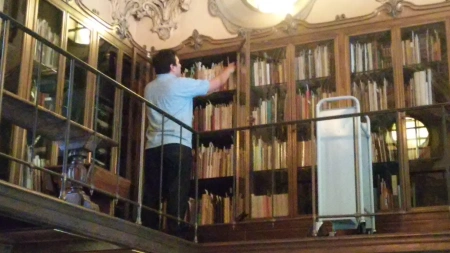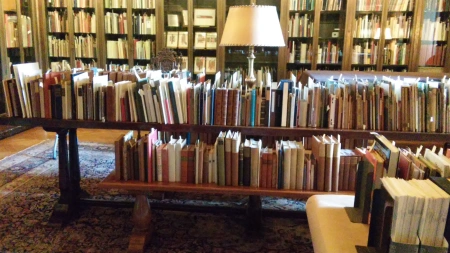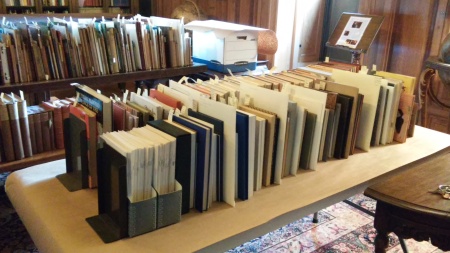By Nina Schneider, Rare Books Librarian
If you haven’t heard (yet!), the Clark is closed for about fourteen months while the building is retro-fitted for earthquakes. Anyone who has experienced the world of construction knows that there is a lot of preparation required before any building activity can start. We’re taking advantage of this period—during meetings, paperwork, and site prep – to do something we’ve wanted to do for many years: reorganize the Clark Library’s fine press collection.
The books that are in the North and South book rooms are those printed in limited editions by private presses primarily during the 20th century, although there are a few 19th (and now 21st century) titles that share the shelves. Since the 1980’s these books were organized by the name of the press, and then alphabetically by main entry, title, and year. Occasionally, the Clark would receive large numbers of items that made interfiling impractical and so some of these collections were scattered wherever we could find room. Following the alphabet took the staff from the main floor of the North book room to the main floor of the South Book room to the mezzanine of the North book room to the mezzanine of the South book room. But wait…if you wanted any book printed (or collected) by Ward Ritchie, you needed to go to the mezzanine of the South book room, and then go back to the mezzanine of the North book room. The staff realized that there had to be a better way, especially after a number of paging requests took an hour (or more) to fill because of the challenge of finding the item.
Academic, public, and private libraries use different classification systems to organize their stacks. Some, such as the Dewey Decimal System and the Library of Congress classification system, organize books by subject. Small libraries organize their books by size, color, or date of acquisition. Although the Clark’s rare and reference books are organized by the Library of Congress classification system, re-classifying the press collection would be Herculean as each of the 10,000 books would need to be recataloged in order to do this. After much discussion and some trial and error, we have come up with a sustainable solution: reorganizing the current collection so that the books are shelved alphabetically by press name but then numbered according to location. For example, all books measuring 11-28 cm that were printed, designed, or written by Eric Gill are now “Press coll. Gill #”. If they measure less than 11 cm, then they are classified as “tiny”; over 28 cm are classified as “folio” or “double folio” for those over 45 cm.
We are also reorganizing how the book rooms are laid out, so that “Press coll. A…” starts on the mezzanine of the North book room, down to the main floor then over to the main floor of the South book room and ending on the mezzanine on the south side. We are allowing extra space at the end of each shelf in order to accommodate future acquisitions.
This is also an excellent opportunity to reconcile the shelf reading project undergone by some of our work/study students and our volunteer, Karen K. It has helped to locate books marked “NOS” (not on shelf) – we’ve already figured out that many of those have been moved to either the miniature book section or to the folio sections, without the updated location added to the card or catalog record.
In the end, this project will benefit both the Clark staff and our patrons. It’s a bit of a luxury to have this time to work on it.
For more information about the Clark’s seismic retrofit: http://www.c1718cs.ucla.edu/clarkclosure15.htm
For more information on library classification systems: http://www.newworldencyclopedia.org/entry/Library_classification



May 14, 2015 at 3:30 pm |
Thanks, Becky, for letting us know about this eminently sensible piece of recataloguing. It’s appreciated. Very best, Joe
LikeLike